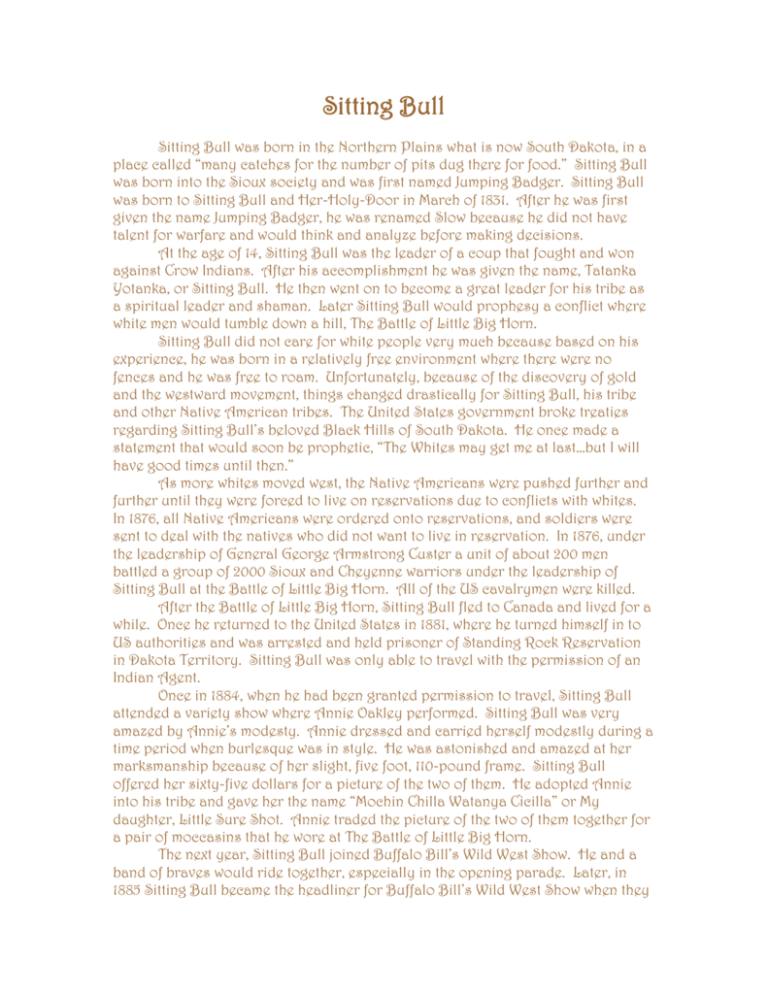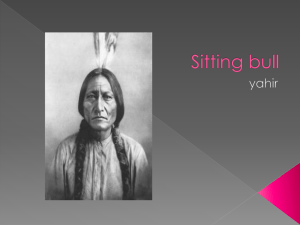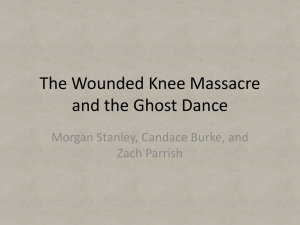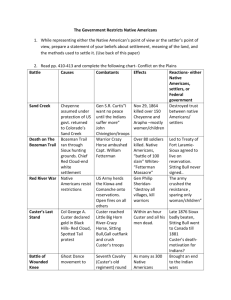Sitting Bull
advertisement

Sitting Bull Sitting Bull was born in the Northern Plains what is now South Dakota, in a place called “many catches for the number of pits dug there for food.” Sitting Bull was born into the Sioux society and was first named Jumping Badger. Sitting Bull was born to Sitting Bull and Her-Holy-Door in March of 1831. After he was first given the name Jumping Badger, he was renamed Slow because he did not have talent for warfare and would think and analyze before making decisions. At the age of 14, Sitting Bull was the leader of a coup that fought and won against Crow Indians. After his accomplishment he was given the name, Tatanka Yotanka, or Sitting Bull. He then went on to become a great leader for his tribe as a spiritual leader and shaman. Later Sitting Bull would prophesy a conflict where white men would tumble down a hill, The Battle of Little Big Horn. Sitting Bull did not care for white people very much because based on his experience, he was born in a relatively free environment where there were no fences and he was free to roam. Unfortunately, because of the discovery of gold and the westward movement, things changed drastically for Sitting Bull, his tribe and other Native American tribes. The United States government broke treaties regarding Sitting Bull’s beloved Black Hills of South Dakota. He once made a statement that would soon be prophetic, “The Whites may get me at last…but I will have good times until then.” As more whites moved west, the Native Americans were pushed further and further until they were forced to live on reservations due to conflicts with whites. In 1876, all Native Americans were ordered onto reservations, and soldiers were sent to deal with the natives who did not want to live in reservation. In 1876, under the leadership of General George Armstrong Custer a unit of about 200 men battled a group of 2000 Sioux and Cheyenne warriors under the leadership of Sitting Bull at the Battle of Little Big Horn. All of the US cavalrymen were killed. After the Battle of Little Big Horn, Sitting Bull fled to Canada and lived for a while. Once he returned to the United States in 1881, where he turned himself in to US authorities and was arrested and held prisoner of Standing Rock Reservation in Dakota Territory. Sitting Bull was only able to travel with the permission of an Indian Agent. Once in 1884, when he had been granted permission to travel, Sitting Bull attended a variety show where Annie Oakley performed. Sitting Bull was very amazed by Annie’s modesty. Annie dressed and carried herself modestly during a time period when burlesque was in style. He was astonished and amazed at her marksmanship because of her slight, five foot, 110-pound frame. Sitting Bull offered her sixty-five dollars for a picture of the two of them. He adopted Annie into his tribe and gave her the name “Mochin Chilla Watanya Cicilla” or My daughter, Little Sure Shot. Annie traded the picture of the two of them together for a pair of moccasins that he wore at The Battle of Little Big Horn. The next year, Sitting Bull joined Buffalo Bill’s Wild West Show. He and a band of braves would ride together, especially in the opening parade. Later, in 1885 Sitting Bull became the headliner for Buffalo Bill’s Wild West Show when they show went to Canada Often when he was asked to address the audience at Buffalo Bill’s Wild West Show he often cursed them in his native Lakota tongue. Buffalo Bill and Sitting Bull had an interesting and complicated relationship that was often hot and cold. Buffalo Bill had once served as an Indian scout for the US Army while Sitting Bull had gained fame from his fight against the US Army at the Battle of Little Big Horn. Whenever their relationship was not going well, Buffalo Bill would send Annie Oakley in to talk to Sitting Bull. Apparently, Annie would try to lift the leader’s spirits by laughing with him and dancing her little jig that she used in performances. However, in 1886, Sitting Bull was denied permission to return to Buffalo Bill’s Wild West Show and said, “The Wigwam is a better place for a red man.” Soon thereafter Sitting Bull became involved in the mystic Ghost Dance. In 1889, a man named Wovoka had visions of a solar eclipse and encouraged tribal members to dance in efforts to make the when man vanish. They Christianized the dance somewhat so that the government would not become suspicious but the dance caught on in other tribes. An Indian police officer was sent to investigate the Ghost Dance for fear that he was trying to raise his people against the United States Government. An American officer who decided to arrest Sitting Bull but he refused. The officer shot him on December 15, 1890, when he refused to be arrested. Thirteen days later, on December 28, American soldiers slaughtered may Sioux men, women, and children at the Battle of Wounded Knee. The whites got Sitting Bull in the end.







